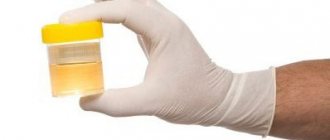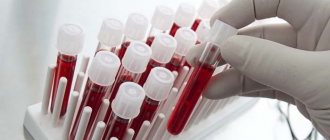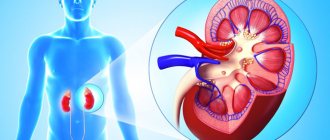Apostematous pyelonephritis is a type of disease related to acute kidney damage.
It is accompanied by the formation of small ulcers in the parenchyma, which often appear in the cortex.
A disease with a complex pathogenetic aspect, associated with repeated bacteremia and spread to deep structures.
At the same time, against the background of this pathology, other organs and systems suffer. Let us consider in detail how the disease occurs, its manifestations, diagnosis and treatment methods.
Causes
The pathogenic process occurs as a result of infection by multiple bacteria, as well as the movement of pathogens into the tubules and renal parenchyma. There are two ways of infection. With ascending, pathogenic microorganisms enter from the external environment, with descending - from the bloodstream.
Currently, there is a list of factors that predispose to the development of inflammation. Among them:
- purulent as well as inflammatory processes in some organs lead to the further development of pathology;
- stagnation of urine helps create conditions for the development of pathogens and their penetration into the kidney tissue. Often the dynamics are disrupted as a result of urolithiasis, bladder dyskinesia, spasms of the ureter, prostate hypertrophy;
- Women are statistically affected more often than men. This is due to the width of the urinary tract, which facilitates the penetration of pathogenic microorganisms;
- The immune response is important in pathogenesis. It often develops after infection. Genetic reactivity or factors affecting the level of immunoactivity are often to blame.
It is worth considering the complication that occurs after purulent pyelonephritis. The reason for this is incorrect or untimely treatment. Among other factors that influence the formation of pathology are the virulence of the infection, congenital disorders of the blood supply, as well as the structure of the tubules.
Recovery prognosis
Apostematous pyelonephritis has a fairly high mortality rate (5-10%). This is due to complications that arise during the pathological process. The prognosis especially worsens with untimely or inadequate therapy. The patient develops urosepsis, which can be fatal.
Chronic pyelonephritis may develop, which often leads to kidney shrinkage and nephrogenic arterial hypertension. If the purulent-inflammatory process affects both kidneys, the prognosis for recovery worsens. The number of deaths can reach up to 15%. After suffering apostematous pyelonephritis, the patient should be under lifelong dispensary observation.
Pathogenesis
Pathogenic symptoms most often make themselves felt due to the entry of bacteria through the blood into the tissues of the excretory organs. With a single penetration of the pathogen, infection may not occur. However, the capillary walls will be damaged. Subsequently, microorganisms penetrate the wall and begin to damage paired organs.
If the outflow of urine is normal, then the bacteria will leave the body on their own, so an inflammatory process will not form. In case of stagnation, pathogens multiply in the lumen of the tubules. This greatly increases the likelihood of a pathogenic process. Bacteria damage the tubular cover. Leukocyte infiltration of nephrons increases and epithelial cells die, and multiple ruptures of the basement membrane also appear.
Bacteria enter tissues. Then peritubular purulent infiltrates are formed, which are not delimited by the inflammatory shaft. In addition, the body is poisoned by inflammatory products. The pustules merge with each other, uniting into large suppurations with an inflammatory shaft. Therefore, the connective tissues grow until the inflammation completely disappears. The outcome is the formation of sclerotic areas where purulent infiltrates were previously present. Ulcers sometimes break through the renal membrane. This involves the peritoneum, as well as surrounding tissues, in a pathological interaction.
Classification
Apostematous pyelonephritis can spread to two kidneys at once, but often affects one. Each of the options is characterized by special symptoms, therefore, due to the clinical manifestation, an appropriate therapeutic approach to treatment can be found. There is also a difference in the forecasts.
Taking into account the basic etiology, the following lesions can be distinguished:
- Primary. This group includes diseases that develop against the background of excretory organs that have not previously been exposed to infection. The infection enters through the bloodstream from inflammatory foci. It develops when the pathogen is highly virulent and the immune system is weakened and unable to resist the disease. However, this classification of lesion is rare.
- Secondary. This variety comes across more often. It includes pathological episodes diagnosed for problems with the urinary system - cystitis, dyskinesia, urolithiasis. Numerous urodynamic disorders play a major role here.
Apostematous pyelonephritis is also divided according to the breadth of its infection. In this case, one-sided and two-sided forms are distinguished. However, due to massive bacteremia, both organs often suffer at once. This form is primary due to the peculiar penetration of the infection - hematogenous. Thus, 95 out of 100 are diagnosed with unilateral kidney damage caused by urodynamic disorders. The activity of the immune system decreases, which increases the likelihood of subsequent complications of this disease and the gradual development of several of its forms.
Symptoms
Clinical manifestations of the pathology are different. Thus, the symptoms of the primary hematogenous type are pronounced. . You feel chills, your body temperature rises, and you feel a dull pain in your lower back. All this indicates intoxication.
The patient is haunted by headaches, decreased appetite, and vomiting. Severe manifestations lead to a decrease in pressure. Tachycardia and confusion occur. Around the fifth or sixth day, a sharp increase in lumbar pain is felt. This means that the inflammation has reached the renal capsule, which causes the risk of its breakthrough.
In the second type, the onset of symptoms is quite easy to recognize in advance. Severe renal colic usually haunts the patient. Their duration can vary from several hours to three days. Sometimes the disease develops after operations on the excretory organs.
Another notable difference is the nature of the damage. So, in the primary version it is two-sided, but in the secondary version it is always one-sided. This is reflected even in the severity of pain in the lumbar region.
Secondary is always accompanied by painful sensations that only intensify over time. However, after a week, the nature and course of both forms do not differ.
In the next stage, the abdominal muscles become rigid. This signals the onset of inflammation directly in the peritoneum. The pyogenic infection systematically spreads throughout the body. The lungs and liver are at risk, and in some cases, even the brain is affected. This, in turn, causes a number of complications, and in some cases, pneumonia.
You may also notice that there is no urine in the body. This is another symptom indicating acute renal failure. Subsequently, this develops into polyuria with a sharp increase in diuresis. In addition, if pathogens reach the liver, jaundice begins to develop.
How to prevent pyelonephritis - Everything will be fine - Issue 380 - 04.24.14 - Everything will be fine
How does the disease manifest itself?
Symptoms of the development of this type of pyelonephritis largely depend on the degree of urinary dysfunction.
Often the disease occurs during severe hypothermia or after a cold.
Symptoms appear quickly and acutely. Body temperature rises sharply, reaching 40˚C. Chills and fever occur.
Signs of severe intoxication of the body quickly appear:
- Cardiopalmus. Feeling as if the heart would jump out of the chest.
- Weakness, constant drowsiness.
- Nausea appears with the addition of vomiting.
- Blood pressure decreases and adynamia occurs.
The pain is felt in the lumbar region, often “dull” at the height of the disease. On the 5th day, the pain intensifies.
If the process is protracted, then the clinical picture unfolds progressively and clearly. The pain intensifies, which is associated with the involvement of the capsule that surrounds the kidneys in the pathological process. Muscle rigidity occurs in the area of the anterior abdominal wall, which is characterized by increased tone, that is, they are in constant tension and hard upon palpation.
The infection enters the lymphatic vessels and spreads to the respiratory system. The first to be affected is the pleura, which surrounds the lungs. Pus forms in this area or excess fluid accumulates.
Purulent foci appear in all organs. The brain and liver are affected. Yellowness of the skin and insufficient liver function develop.
Complications
Apostematous pyelonephritis often provokes the occurrence of acute renal failure. Moreover, it can develop even with toxic-septic damage to the kidneys. It is accompanied by various complications, for example, the gradual formation of abscesses, pneumonia, and some processes affect the liver and pleura. This occurs due to the fact that pathogens spread along with the blood, pass through the body through the lymph nodes, infecting various organs.
Urosepsis is rightfully recognized as the most severe complication. The consequences of the pathological process sometimes include fibrosis, as well as problems with the juxtaglomerular apparatus. As a rule, this occurs when the kidney shrinks. As a result, erythropoiesis is disrupted, polycythemia and hypoplastic anemia occur. One of the obvious signs can also be called low blood pressure.
Apostematous pyelonephritis
Apostematous pyelonephritis is usually considered as one of the severe forms of acute purulent pyelonephritis. Some authors consider it a complication of this disease. There is a relationship between the pathology and another form of purulent-inflammatory damage to the excretory organs - kidney carbuncle. There is an opinion that the conditions “purulent pyelonephritis – apostematous inflammation – carbuncle – kidney abscess” are successive stages of the same pathological process. The exact prevalence is unknown, but it is estimated that the disease occurs in 5-12% of cases of acute pyelonephritis. With delayed diagnosis and late initiation of treatment, the risk of developing pathology increases. In childhood, youth and adulthood, women suffer several times more often than men; in the age group over 60 years, the morbidity pattern evens out.
Diagnostics
The pathology in its acute form develops very quickly, and the risk of dangerous complications is quite high. Therefore, the patient requires correct and quick diagnosis. A doctor can determine the presence of such a pathology; he prescribes both instrumental and laboratory tests:
- Physical examination and follow-up interview. The urologist analyzes the patient’s complaints, collects an anamnesis of the disease, and then clarifies whether there are diseases of the urinary organs. Next, it is important to find out in what order the symptoms appeared. Through palpation, the urologist identifies pain, determines the size of the kidney and checks its enlargement.
- Research in the laboratory. During the first days, a general urine test practically does not show any changes. Then microhematuria, proteinuria, and leukocyturia are detected. When conducting sediment microscopy, specialists identify bacteria. A general blood test usually shows results consistent with acute inflammatory processes.
- Ultrasound examination. Thanks to ultrasound, it is possible to determine the enlargement of one kidney or two at once, swelling of the surrounding tissue, decreased mobility with clearly forced breathing. After 2-3 days, a high acoustic density of the parenchyma is noted. In its thickness there are several small dense formations.
- CT scan. This study allows us to detect the location of the abscess and its size.
After a thorough examination, the optimal therapeutic regimen is prescribed.
Treatment
The main treatment method is surgery. Other methods are considered secondary, since they are used exclusively for weakened patients who are unable to undergo a full-fledged operation. Subsequent therapy also plays an important role. It supports vital functions, reduces the severity of intoxication and restores the activity of the entire excretory system.
Treatment is carried out according to a specific algorithm:
- The kidney is decapsulated.
- Drainage of ulcers, as well as retroperitoneal tissue.
- Pyelostomy, which allows the formation of temporary pathways for the outflow of urine.
- If the lesions are unilateral, patients are prescribed nephrectomy.
Antibacterial drugs are prescribed after the diagnosis has been clarified and the nature of the corresponding pathogen has been determined. Then it is important to find out the sensitivity of the pathogen to certain drugs. The medication continues even after recovery from surgery.
Both before and after surgery, the patient is prescribed infusion treatment. It is selected taking into account the filtration capabilities of the kidneys. The patient is administered various vitamins and enzymes. Acute failure becomes the reason for hemodialysis, the frequency of which directly depends on urological parameters.
The duration of therapeutic measures is determined individually based on the general condition of the patient. After surgery, the patient requires systematic monitoring of the condition of the kidneys in order to determine daily diuresis, as well as creatinine levels. This helps avoid relapse.
Effective Treatment Options
How to treat apostematous pyelonephritis? When a disease is diagnosed, it is necessary to urgently take measures to eliminate it. A surgical intervention is performed, including revision and decapsulation of the kidney. The kidney stands out from the fatty perinephric tissue. If there are ulcers, the fibrous capsule is dissected along the rib, carefully peeled off and removed. If pustular lesions arise against the background of acute secondary nephritis, drainage of the organ is performed. After excision of the capsule, several special tampons are placed to the kidney, a drainage tube is placed to remove the purulent contents and restore the passage of urine. The drainage is removed a few weeks after urinary outflow is restored.
After the operation, it is necessary to eliminate the resulting purulent intoxication and restore kidney functionality. The patient is given intravenous administration of a complex of drugs:
- glucose 20%,
- sodium chloride 0.9%,
- hemodez,
- cocarboxylase,
- pyridoxine,
- vitamin C,
- mannitol 15%,
- furosemide,
- native plasma,
- uncompensated
Severe purulent intoxication is stopped using plasmaphoresis and hemosorption. In people over 60 years of age, with extensive kidney damage, it is sometimes recommended to resort to nephrectomy to save the patient’s life.
Find out about the causes of kidney infarction and the rules for treating the disease.
The symptoms of a bruised kidney and the treatment of the injured organ are written on this page.
Go to https://elesto.ru/diagnostika/analizy/yarko-zheltaja-mocha.html and read about the causes of bright yellow urine in women and treatment options for concomitant pathologies.
Prognosis and prevention
There are quite a lot of deaths in this situation, one in ten cases. To improve the prognosis, you should consult a doctor in a timely manner and begin treatment. Maximum caution should be observed by people with chronic kidney pathologies, and if any symptoms of exacerbation occur, you should rush to consult a specialist.
Disease prevention:
- avoid hypothermia of the lumbar region;
- observe the rules of hygiene;
- fully treat any genitourinary diseases.










